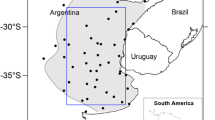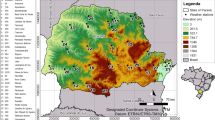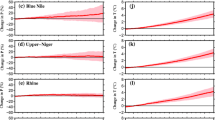Abstract
Hydrological processes and crop growth were simulated for the state of Brandenburg (Germany) using the hydrological/vegetation/water quality model SWIM, which can be applied for mesoscale river basins or regions. Hydrological validation was carried out for three mesoscale river basins in the area. The crop growth module was validated regionally for winter wheat, winter barley and maize. After that the analysis of climate change impacts on hydrology and crop growth was performed, using a transient 1.5 K scenario of climate change for Brandenburg and restricting the crop spectrum to the three above mentioned crops. According to the scenario, precipitation is expected to increase. The impact study was done comparing simulation results for two scenario periods 2022–2030 and 2042–2050 with those for a reference period 1981–1992. The atmospheric CO2 concentrations for the reference period and two scenario periods were set to 346, 406 and 436 ppm, respectively. Two different methods – an empirical one and a semi-mechanistic one – were used for adjustment of net photosynthesis to altered CO2. With warming, the model simulates an increase of evapotranspiration (+9.5%, +15.4%) and runoff (+7.0%, +17.2%). The crop yield was only slightly altered under the “climate change only” scenario (no CO2 fertilization effect) for barley and maize, and it was reduced for wheat (−6.2%, −10.3%). The impact of higher atmospheric CO2 compensated for climate-related wheat yield losses, and resulted in an increased yield both for barley and maize compared to the reference scenario. The simulated combined effect of climate change and elevated CO2 on crop yield was about 7% higher for the C3 crops when the CO2 and temperature interaction was ignored. The assumption that stomatal control of transpiration is taking place at the regional scale led to further increase in crop yield, which was larger for maize than for wheat and barley. The regional water balance was practically not affected by the partial stimulation of net photosynthesis due to higher CO2, while the introduction of stomatal control of regional transpiration reduced evapotranspiration and enlarged notably runoff and ground water recharge.
Similar content being viewed by others
References
J.G. Arnold, P.M. Allen and G. Bernhardt, A comprehensive surface-groundwater flow model, J. Hydrol. 142 (1993) 47–69.
J.G. Arnold, J.R. Williams, A.D. Nicks and N.B. Sammons, SWRRB — A Basin Scale Simulation Model for Soil and Water Resources Management (Texas A&M University Press, College Station, 1990).
J.G. Arnold, J.R. Williams, R. Srinivasan, K.W. King and R.H. Griggs, SWAT, Soil and Water Assessment Tool (USDA, Agriculture Research Service, Grassland, Soil and Water Research Laboratory, Temple, TX, 1994).
A. Becker, Criteria for a hydrologically sound structuring of large scale land surface process models, in: Advances in Theoretical Hydrology, ed. J.P. O'Kane (Elsevier, Amsterdam, 1992) pp. 97–112.
K.J. Beven, A discussion of distributed hydrological modelling, in: Distributed Hydrological Modelling, eds. M.B. Abbott and J.C. Refsgaard (Kluwer, Dodrecht, 1996) pp. 255–296.
D. Easmus, The interaction of rising CO2 and temperatures with water use efficiency: commissioned review, Plant Cell Environ., Special Issue: Elevated CO2 Levels 14(8) (1991) 843–852.
W.E. Easterling, PR. Crosson, N.J. Rosenberg, M.S. Mckenney, L.A. Katz and K.M. Lemon, Paper 2. Agricultural impacts of and responses to climate change in the Missouri-Iowa-Nebraska-Kansas (MINK) region, Clim. Change 24 (1993) 23–61.
W.E. Easterling, H.J. Rosenberg, M.S. McKenney and C.A. Jones, An introduction to the methodology, the region of the study, and a historical analogue of climate change, Agric. Forest Meteorol. 59 (1992) 3–16.
F.W. Gerstengarbe and P. Werner, personal communication (1997).
D. Godwin, J. Ritchie, U. Singh and L. Hunt, A Users Guide to CERES-Wheat-V2.10 (International Fertilizer Development Center, Simulation Manual IFDC-SM-2, 1990).
J. Goudrian and P. Ketner, A simulation study of the global carbon cycle including man's impact on the biosphere, Clim. Change 6 (1984) 167–192.
R. Grant, Dynamics of energy, water, carbon and nitrogen in agricultural ecosystems: Simulation and experimental validation, Ecol. Modelling 81 (1995) 169–181.
S. Grossman, T. Kartschall, B.A. Kimball, D.J. Hunsaker, R.L. La-Morte, R.L. Garcia, G.W. Wall and P.J. Pinter, Jr., Simulated responses of energy and water fluxes to ambient atmosphere and free-air carbon dioxide enrichment in wheat, J. Biogeogr. 22 (1995) 601–610.
P.C. Harley, R.B. Thomas, J.F. Reynolds and B.R. Strain, Modelling photosynthesis of cotton grown in elevated CO2, Plant Cell Environ. 15 (1992) 271–281.
P.G. Jarvis and K.G. McNoughton, Stomatal control of transpiration: scaling up from leaf to region, Adv. Ecol. Res. 15 (1986) 1–49.
T. Kartschall, S. Grossman, F. Wechsung and W. Poschenrieder, Untersuchung der Auswirkungen von Klimaänderungen auf Agrarökosysteme Abschlußbericht zum Vorhaben, BMBF 01LK 9107–5 115 S (1995).
G.J. Kenny, P.A. Harrison and M.L. Parry, eds., The Effect of Climate Change on Agricultural and Horticultural Potential in Europe (Environmental Change Unit, University of Oxford, Oxford, 1993).
B.A. Kimball, R.L. LaMorte, P.J. Pinter, Jr., G.W. Wall, D.J. Hunsaker, F.J. Adamsen, S.W. Leavitt, T.L. Thompson, A.D. Matthias and T.J. Brooks, Free-air CO2 enrichment (FACE) and soil nitrogen effects on energy balance and evapotranspiration of wheat, Water Resources Res., in press.
B.A. Kimball, P.J. Pinter, Jr., R.L. Garcia, R.L. Lamorte, G.W. Wall, D.J. Hunsaker, G. Wechsung, F. Wechsung and T. Kartschall, Productivity and water use of wheat under free-air CO2 enrichment, Global Change Biol. 1 (1995) 429–442.
V. Krysanova and H. Luik, eds., Simulation Modelling of a System Watershed-River-Sea Bay (Valgus, Tallinn, 1989) (in Russian).
V. Krysanova, A. Meiner, J. Roosaare and A. Vasilyev, Simulation modelling of the coastal waters pollution from agricultural watershed, Ecol. Modelling 49 (1989) 7–29.
V. Krysanova, D.I. Müller-Wohlfeil and A. Becker, Integrated modelling of hydrology and water quality in mesoscale watersheds, in: PIK Report No. 18 (Potsdam Institute for Climate Impact Research, Potsdam, 1996).
V. Krysanova, D.I. Müller-Wohlfeil and A. Becker, Development and test of a spatially distributed hydrological/water quality model for mesoscale watersheds, Ecol. Modelling 106(1,2) (1998) 261–289.
L.S. Kuchment, The construction of continental scale models of the terrestrial hydrological cycle: an analysis of the state-of-the-art and future prospects, in: Advances in Theoretical Hydrology, ed. J.P. O'Kane (Elsevier, Amsterdam, 1992) pp. 113–128.
J.I.L. Morrison, Response of plants to CO2 under water limited conditions, Vegetation 104/105 (1993) 193–209.
J.E. Nash and J.V. Sutcliffe, River flow forecasting through conceptional models, 1. A discussion of principles, J. Hydrol. 10 (1970) 282–290.
Ökologische Ressourcenplannung Berlin und Umland, UBA Texte 22/93 (Umweltbundesamt, Berlin, 1993).
R.M. Peart, J.W. Jones, R.B. Curry, K. Boote and L.H. Allen, Jr., Impact of climate change on crop yield in the south-eastern USA, in: The Potential Effects of Global Climate Change on the United States, eds. J.B. Smith and D.A. Tirpak (US EPA, Washington, DC, 1989).
C. Rosenzweig and M.L. Parry, Potential impact of climate change on world food supply, Nature 367 (1994) 133–138.
J. Rotmans and M.G.J. den Elzen, Modelling feedback mechanisms in the carbon cycle: balancing the carbon budget, Tellus 45 B (1993) 1–20.
C.J.T. Splitters, H. van Keulen and D.W.G. van Kraalingen, A simple and universal crop growth simulator: SUCROS87, in: Simulation and Systems Management in Crop Protection, eds. R. Rabbinge, S.A. Ward and H.H. van Laar (Pudoc, Wageningen, 1989) pp. 147–181.
R. Srinivasan and J.G. Arnold, Basin scale water quality modelling using GIS, in: Proc. Appl. Adv. Inform. Technol. Manag. Nat. Res., 17–19 June 1993, Spokane, WA, pp. 475–484.
R. Srinivasan, J.G. Arnold, R.S. Muttiah, C. Walker and P.T. Dyke, Hydrologic unit model for the United States (HUMUS), in: Advances in Hydro-Science and Engineering, Vol. I, ed. S.S.Y. Wang (1993) pp. 451–456.
U.S. Army Corps of Engineers, GRASS Reference Manual (USA CERL, Champaign, IL, 1987).
K.O. Wenkel and W. Mirschel, Agroökosystemmodellierung Grundlage für die Abschätzung von Auswirkungen möglicher Landnutzungs-und Klimaänderungen, ZALF-Bericht 24 (1995) 187.
J.R. Williams, C.A. Jones, J.R. Kiniry and D.A. Spanel, The EPIC crop growth model, in: The Transactions of the ASAE, Vol. 32,No. 2 (Am. Soc. Agric. Engineers, St. Joseph, MI, 1989) pp. 497–511.
J.R. Williams, K.G. Renard and P.T. Dyke, EPIC — a new model for assessing erosion's effect on soil productivity, J. Soil Water Conserv. 38(5) (1984) 381–383.
Author information
Authors and Affiliations
Rights and permissions
About this article
Cite this article
Krysanova, V., Wechsung, F., Becker, A. et al. Mesoscale ecohydrological modelling to analyse regional effects of climate change. Environmental Modeling & Assessment 4, 259–271 (1999). https://doi.org/10.1023/A:1019020518977
Issue Date:
DOI: https://doi.org/10.1023/A:1019020518977




